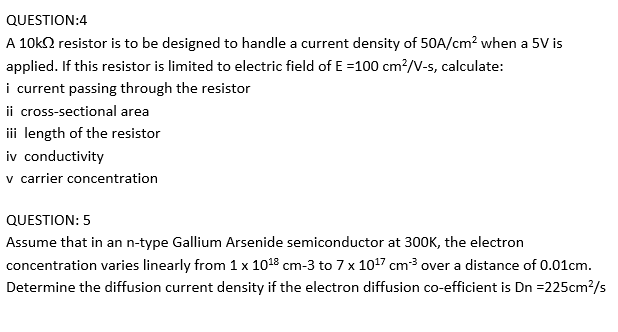KUESTION: 1 Silicon at T=300K contains a acceptor impurity concentration at Na=1016 cm-3. Determine the concentration of donor impurity atoms that must be added so that the silicon is n-type and the Fermi energy is 0.20eV below the conduction band edge. [Take NC=2.8 x 1019cm³].
KUESTION: 1 Silicon at T=300K contains a acceptor impurity concentration at Na=1016 cm-3. Determine the concentration of donor impurity atoms that must be added so that the silicon is n-type and the Fermi energy is 0.20eV below the conduction band edge. [Take NC=2.8 x 1019cm³].
Principles of Instrumental Analysis
7th Edition
ISBN:9781305577213
Author:Douglas A. Skoog, F. James Holler, Stanley R. Crouch
Publisher:Douglas A. Skoog, F. James Holler, Stanley R. Crouch
Chapter7: Components Of Optical Instruments
Section: Chapter Questions
Problem 7.14QAP
Related questions
Question
100%
![QUESTION: 1
Silicon at T=300K contains a acceptor impurity concentration at Na=1016 cm-3. Determine
the concentration of donor impurity atoms that must be added so that the silicon is n-type
and the Fermi energy is 0.20eV below the conduction band edge. [Take NC=2.8 x 101°cm³].
QUESTION:2
Two semiconductor materials have exactly the same properties except that material A has a
band gap energy of 1.0eV and material B has a band gap energy of 1.2eV. Determine the
ratio of ni of material A to that of material B for T=30OK.
QUESTION:3
A special semiconductor material is to be "designed". The semiconductor is to be n-type and
doped with 1 x 1015 cm³ donor atoms. Assume complete ionization and that Na=0. The
effective density of state functions are given by Nc = Nv =1.5 x 1019 cm3 and are
independent of temperature. A particular semiconductor device fabricated with this
material requires the electron concentration to be no greater than 1.01 x 1015 cm³ at
T=400K. What is the minimum value of the band gap energy?](/v2/_next/image?url=https%3A%2F%2Fcontent.bartleby.com%2Fqna-images%2Fquestion%2F257851fa-69aa-459d-a592-32cf62860e49%2F84640aa0-cea5-4386-b9d2-75f1847b475d%2Fv0awce_processed.png&w=3840&q=75)
Transcribed Image Text:QUESTION: 1
Silicon at T=300K contains a acceptor impurity concentration at Na=1016 cm-3. Determine
the concentration of donor impurity atoms that must be added so that the silicon is n-type
and the Fermi energy is 0.20eV below the conduction band edge. [Take NC=2.8 x 101°cm³].
QUESTION:2
Two semiconductor materials have exactly the same properties except that material A has a
band gap energy of 1.0eV and material B has a band gap energy of 1.2eV. Determine the
ratio of ni of material A to that of material B for T=30OK.
QUESTION:3
A special semiconductor material is to be "designed". The semiconductor is to be n-type and
doped with 1 x 1015 cm³ donor atoms. Assume complete ionization and that Na=0. The
effective density of state functions are given by Nc = Nv =1.5 x 1019 cm3 and are
independent of temperature. A particular semiconductor device fabricated with this
material requires the electron concentration to be no greater than 1.01 x 1015 cm³ at
T=400K. What is the minimum value of the band gap energy?

Transcribed Image Text:QUESTION:4
A 10k2 resistor is to be designed to handle a current density of 50A/cm? when a 5V is
applied. If this resistor is limited to electric field of E =100 cm²/V-s, calculate:
i current passing through the resistor
ii cross-sectional area
ii length of the resistor
iv conductivity
v carrier concentration
QUESTION: 5
Assume that in an n-type Gallium Arsenide semiconductor at 300K, the electron
concentration varies linearly from 1 x 1018 cm-3 to 7 x 1017 cm3 over a distance of 0.01cm.
Determine the diffusion current density if the electron diffusion co-efficient is Dn =225cm?/s
Expert Solution
This question has been solved!
Explore an expertly crafted, step-by-step solution for a thorough understanding of key concepts.
This is a popular solution!
Trending now
This is a popular solution!
Step by step
Solved in 3 steps

Knowledge Booster
Learn more about
Need a deep-dive on the concept behind this application? Look no further. Learn more about this topic, chemistry and related others by exploring similar questions and additional content below.Recommended textbooks for you

Principles of Instrumental Analysis
Chemistry
ISBN:
9781305577213
Author:
Douglas A. Skoog, F. James Holler, Stanley R. Crouch
Publisher:
Cengage Learning

Principles of Instrumental Analysis
Chemistry
ISBN:
9781305577213
Author:
Douglas A. Skoog, F. James Holler, Stanley R. Crouch
Publisher:
Cengage Learning